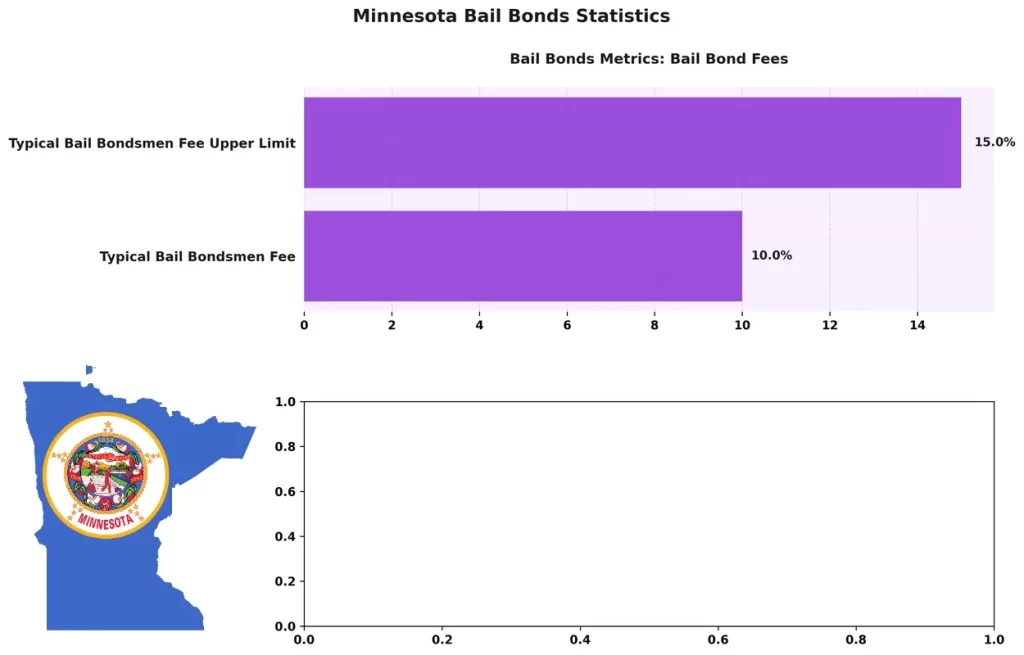How Bail Bonds Work in Minnesota: Info You Need To Get out of Jail Quick
Navigating the legal system can be daunting, especially when dealing with bail bonds in Minnesota, where understanding the bail bond process is crucial.
This guide offers crucial insights into bail bonds, explaining their purpose, the bail process, and the costs involved, including types of bail and bail bond fees. You’ll learn about the role of bail bondsmen, how to choose a reputable one, and understand the consequences if a defendant misses a court appearance, which may involve bail violations or bond forfeiture.
We’ll also explore alternatives to bail, such as property bonds and cash bonds, and answer common questions about documentation and co-signing. With this comprehensive overview, you’ll be well-equipped to handle any bail situations that come your way and how bail works.
What are bail bonds, and how do they function in Minnesota?

Bail bonds are an integral part of the legal system, enabling defendants in Minnesota to secure their release from jail while awaiting trial. This process involves working with a bail bond agent who provides the necessary funds, typically set according to the bail amount determined during a bail hearing. Bail bond companies offer surety bonds as a way to fulfill these financial obligations.
A bail arrangement show how bail works to allow defendants to maintain their freedom and adequately prepare for their court appearance, ensuring compliance with the legal obligations outlined in the bail agreement. Understanding how bail bonds operate is essential for anyone navigating the bail process in Minnesota, particularly in light of state regulations and the criminal justice system, including Minnesota statutes governing bail.
The bail bond serves as a financial guarantee that the defendant will appear in court, thereby reducing the escape risk and promoting accountability within the legal framework. In Minnesota, licensed bail agents play a vital role by assessing eligibility and structuring agreements that often include a fee, usually a percentage of the total bail amount.
By leveraging the expertise of these agents, defendants can gain clarity on their rights and responsibilities, ultimately facilitating a smoother re-entry into society while awaiting judicial proceedings. This system not only supports individuals but also upholds the judicial process by ensuring that court schedules and the court docket are respected.
Minnesota Bail Bonds Statistics

The Minnesota Bail Bonds Statistics provide insight into the financial and operational aspects of the bail bonds industry within the state. This data sheds light on typical fees charged by bail bondsmen and highlights areas where further research or policy development may be necessary, particularly in terms of conditional bail and bail bond regulations.
Bail Bond Fees reveal that the typical fee charged by bail bondsmen is around 10% of the bail amount. This fee can go up to an upper limit of 15%, depending on various factors such as the perceived risk of the defendant or the complexity of the case. These fees are crucial for the bondsmen as they cover the risk of the accused not appearing in court and the operational costs of the bail business, including bail bond collateral management.
- The fee structure highlights a balance between accessibility for defendants who may not have the full bail amount and profitability for bail bondsmen. This balance is essential for the sustainability of bail services while ensuring that defendants can secure their release pending trial, with the support of indemnitors and co-signers.
If my bail is $150,000, how much should I pay?
Need to know how much your Minnesota bail is going to be? To help calculate your bail, we’ve set up a simple bail schedule. Below is a simple table to help you better understand the premium rates for bail. Here, we will calculate bail using a standard of 10%:
| CASH BAIL AMOUNT | PREMIUM % | BAIL COST |
|---|---|---|
| $1000 | 10% | $100 |
| $5,000 | 10% | $500 |
| $10,000 | 10% | $1,000 |
| $20,000 | 10% | $2,000 |
| $50,000 | 10% | $5,000 |
| $100,000 | 10% | $10,000 |
| $150,000 | 10% | $15,000 |
| $250,000 | 10% | $25,000 |
| $500,000 | 10% | $50,000 |
| $1,000,000 | 10% | $100,000 |
Conditional Bail refers to bail granted with specific stipulations designed to ensure court appearances and manage risks such as flight. The dataset indicates a lack of quantified data on flight risk reduction impact, suggesting an area ripe for further exploration and analysis. Understanding the effectiveness of conditional bail in reducing flight risks could inform policy decisions aimed at improving the justice system’s efficiency and fairness, especially in the context of pretrial detention and bail reform.
Overall, the Minnesota Bail Bonds Statistics highlight the importance of transparent and fair fee structures and point to potential areas for research in conditional bail’s effectiveness. Both aspects are vital for ensuring the system serves its purpose of balancing individual freedom and public safety, underlining the role of bail bond agencies in this context.
What is the bail process in Minnesota, and how is bail set?
The bail process in Minnesota commences at the moment of arrest, with the defendant’s bail amount being established during a bail hearing. This hearing plays a critical role in determining whether the defendant can achieve pretrial release, taking into account various factors such as the severity of the crime, flight risk, and the quality of the defendant’s legal representation. Bail bond applications and bonding process details are often discussed during this time.
Familiarizing yourself with the bail schedule can greatly assist defendants and their families in effectively navigating the complexities of bail applications and the overall bail process, including understanding bail bond premiums and release conditions.
To fully understand how this system operates, it is essential to recognize that the judge or magistrate considers multiple factors before determining a bail amount. These factors typically include the defendant’s rights and may consider:
- The nature of the alleged offense
- The defendant’s prior criminal history
- Their ties to the community, which may indicate the likelihood of appearing at future court dates
The availability of a bail schedule offers a preliminary framework, providing guidelines for standard bail amounts based on specific charges. Defendants who wish to contest their bail have the option to submit written motions, which can lead to additional hearings where arguments may be presented for reduced bail or alternative release conditions.
Grasping these procedures not only clarifies the steps involved but also give the power tos individuals facing this challenging situation.
How much do bail bonds typically cost in Minnesota?
In Minnesota, the cost of bail bonds generally involves a premium that ranges from 10-15% of the total bail amount established by the judge. This premium, which you or an indemnitor pays to the bail bondsman, is what allows the defendant to secure their jail release. It is crucial for families seeking financial assistance during this challenging time to understand the associated bail conditions and financial responsibility involved.
These premiums can vary based on several factors, including the nature of the criminal charges, the defendant’s criminal history, and the perceived risk of flight. For individuals who cannot afford the premium upfront, payment plans may be available, providing some relief from the financial burden through structured bail bond solutions.
It is important to recognize that while the premium is non-refundable, the overall cost may be influenced by any additional fees or conditions set by the bail bondsman. Therefore, maintaining clear communication regarding payment expectations is essential.
What factors influence the cost of a bail bond in Minnesota?
The cost of a bail bond in Minnesota can be influenced by several factors, including the bail amount set by the judge, the severity of the crime charged, and the defendant’s assessed flight risk. Bail bond agents perform a comprehensive risk assessment to determine the premium required, which can vary significantly based on these considerations and the conditions of release.
The nature of the alleged offense is a critical factor; for instance, serious felonies typically result in higher bail amounts compared to misdemeanors, reflecting the increased legal stakes involved. If the defendant has a history of skipping court appearances or is deemed a higher flight risk, this can lead to elevated bond premiums and potential modification of bail terms.
Ultimately, these financial obligations not only impact the immediate out-of-pocket expenses for the accused but also play a significant role in shaping their overall strategy in navigating the legal process. Therefore, it is essential to understand the various underlying factors at play.
What is the role of a bail bondsman in Minnesota?
In Minnesota, a bail bondsman plays a crucial role in the bail process by providing the necessary financial support for a defendant’s release from jail. This professional serves as an intermediary between the defendant and the court, ensuring compliance with bond conditions and enforcing agreements in the event the defendant fails to appear for their court date.
Understanding the responsibilities of a bail bondsman is essential for effectively navigating the complexities of the bail system.
Bail bondsmen are not only instrumental in securing the funds required for bail, but they also educate defendants about their obligations. This includes clarifying the importance of attending all scheduled court appearances and adhering to the conditions set by the judge.
If a defendant misses a court date, a bail bondsman employs various methods to locate them, including fugitive recovery, underscoring their role in bond enforcement. Ultimately, their involvement facilitates the defendant’s temporary freedom while ensuring accountability throughout the judicial process.
How do you choose a reputable bail bondsman in Minnesota?

Selecting a reputable bail bondsman in Minnesota is essential for facilitating a smooth bail process and securing the release of the defendant. Consider factors such as the bondsman’s experience, customer reviews, and their familiarity with local laws and regulations, including bail bond licensing and Minnesota bail laws.
It is also advisable to evaluate the bond company’s payment plans and their transparency in discussing bail terms and conditions.
You should take the necessary time to verify the bondsman’s licensing and certification, as these credentials often indicate a commitment to professional standards and ethical practices.
Engaging with past clients through testimonials can provide valuable insights into the reliability and efficiency of the bail bond agents you are considering. A company that prioritizes client satisfaction and maintains a strong reputation within the community is more likely to offer dependable support during what can be a challenging time.
Ultimately, conducting thorough research and careful consideration will help ensure a trustworthy choice, offering you peace of mind as you navigate the complexities of the legal system and the criminal justice system.
What happens if the defendant fails to appear in court after obtaining a bail bond?
If a defendant fails to appear in court after obtaining a bail bond, several serious consequences may follow, including the potential forfeiture of the bail. The bail bondsman has the right to initiate bond enforcement measures and fugitive recovery to recover any financial losses incurred by the court due to the defendant’s absence, which can impact both the defendant and their co-signers.
This situation can lead to significant financial strain, as co-signers may be held responsible for the full amount of the bail, resulting in unexpected financial burdens. Additionally, the court may issue a bench warrant for the defendant’s arrest, complicating their legal standing and potentially resulting in additional charges.
The psychological stress of facing these repercussions can be substantial, affecting personal relationships and future legal proceedings.
Understanding the importance of adhering to court schedules and bail conditions is crucial, as the consequences of a missed appearance extend beyond immediate legal ramifications, creating a ripple effect that can influence overall life stability.
Are there alternatives to bail bonds in Minnesota?
In Minnesota, you have several alternatives to traditional bail bonds that you may explore, including personal recognizance, property bonds, and pretrial release options. These alternatives are designed to promote community safety while allowing you to avoid the financial burden associated with bail bonds, as long as you adhere to specific bail conditions set by the court.
For example, personal recognizance enables you to secure your release without paying bail; you simply sign a contract promising your appearance in court. Pretrial release, in contrast, typically involves oversight through reporting to a supervising agency, which can be advantageous for individuals with strong community ties.
Your eligibility for these options generally depends on factors such as the nature of the charges, your prior criminal history, and the likelihood of flight risks. Understanding these alternatives not only give the power tos you but also contributes to a more equitable judicial process, balancing community needs with individual circumstances.
How long does it take to get released on a bail bond in Minnesota?
The time required for a bail bond release in Minnesota can vary based on several factors, including the jail’s processing speed, the complexity of the bail paperwork, and the availability of the bail bond agent. Typically, once all documents are completed and funds are secured, the jail release process may occur within a few hours to a full day.
The actual timeline for release can also be influenced by additional elements, such as the time of day the bail is posted and the current workload of the facility. For example, if the bail is posted during peak hours or at night, the process may take longer due to limited staff availability, affecting the bail bond service.
Similarly, if the charges are more complicated or if there are potential holds from other jurisdictions, these factors can further extend the duration of the release.
It is essential for individuals seeking bail to maintain communication with their bond agent to stay informed about any changes that may impact their release timeline.
What documentation do you need to obtain a bail bond in Minnesota?
To obtain a bail bond in Minnesota, you will typically need several key documents, including a completed bail application, identification, and relevant bail paperwork that outlines the terms of the bond. Engaging legal representation can also ensure that all necessary documentation is properly organized for a smooth transaction and adherence to Minnesota statutes.
Plus these essentials, it is advisable to prepare financial statements to demonstrate your ability to cover costs, as well as any collateral documents that may further support the bail process and fulfill the conditions of release.
Approaching the bail paperwork with meticulous attention to detail is crucial, as any missing information could lead to delays or complications. The importance of accurate documentation cannot be overstated; having a complete and organized application can expedite the process and alleviate stress for everyone involved.
Being well-prepared with the right documentation can significantly enhance your chances of securing a favorable bail arrangement.
Can you get a bail bond for a minor in Minnesota?

In Minnesota, obtaining a bail bond for a minor is indeed possible, but it often involves additional steps and requires the participation of a parent or legal guardian as an indemnitor. Minnesota laws outline specific procedures designed to protect the rights of the minor throughout the bail agreement process.
Understanding these procedures is essential, as minors are treated differently under the law. This underscores the importance of parental guidance and support in navigating these complexities. Guardians must not only grasp the financial implications of securing a bail bond but also the obligations associated with it, including ensuring the minor’s court appearance.
Legal requirements may necessitate a hearing where the court evaluates the suitability of the guardian to act on behalf of the minor. Therefore, being well-informed about these intricacies is crucial for anyone seeking a bail bond for a young individual in Minnesota.
What rights do you have as a co-signer on a bail bond in Minnesota?
As a co-signer on a bail bond in Minnesota, you possess specific rights and obligations that are essential for both the defendant and yourself. These rights include the duty to be informed of any changes related to the bail agreement, while your obligations involve ensuring the defendant complies with all bail conditions to prevent financial repercussions.
It is important to understand that failing to meet these bail obligations can result in significant legal and financial consequences. If the defendant does not appear in court, you may be held liable for the full amount of the bond. This underscores the necessity of monitoring the defendant’s adherence to court requirements closely.
In Minnesota, you have the right to seek legal counsel if any issues arise, allowing you to protect your interests effectively. By recognizing these responsibilities, you can facilitate a smoother bail process and reinforce the critical role of co-signers within the broader legal framework of the bail bond industry.
How does the bail bond process differ for misdemeanors versus felonies in Minnesota?
The bail bond process in Minnesota varies significantly between misdemeanors and felonies, primarily due to the differing severity of the charges involved. Misdemeanors typically allow for more lenient bail conditions and quicker release times, whereas felonies may involve higher bail amounts and stricter conditions set by the court.
This distinction arises from the potential consequences of each offense, as misdemeanors usually carry less severe penalties and lower risks to public safety. In contrast, felony charges reflect serious allegations that can lead to substantial imprisonment, resulting in stricter oversight.
Consequently, individuals facing a felony charge may encounter a more complex bail process, which could require additional documentation and potentially the involvement of legal counsel.
Furthermore, the likelihood of pre-trial detention increases for felony cases, underscoring the importance of understanding these differences when navigating the bail bond landscape in Minnesota and consulting with licensed bail agents.
What are the potential risks of using a bail bond in Minnesota?
Utilizing a bail bond in Minnesota involves inherent risks that both defendants and co-signers must carefully consider, particularly the possibility of bail forfeiture if the defendant fails to appear in court. The bond enforcement process can have significant implications for the financial and legal responsibilities of all parties involved, including the potential involvement of bail bond companies.
When a defendant does not fulfill their court obligations, the consequences extend beyond the forfeiture of the bail amount. It may result in increased financial strain due to the requirement to pay the full bail amount, along with potential legal fees associated with bond enforcement actions.
This highlights the importance of recognizing that the bond serves primarily as a guarantee for the court’s interests, thereby making co-signers liable for any remaining costs if the bond is revoked. Bond enforcement agents may pursue the defendant aggressively, which could lead to further complications, including additional legal penalties or even arrest by bail agents.
Therefore, it is essential for those considering a bail bond to weigh these financial and legal obligations seriously before proceeding.
How can you avoid common pitfalls when dealing with bail bonds in Minnesota?
To avoid common pitfalls when dealing with bail bonds in Minnesota, it is essential for you to thoroughly understand the bail conditions and obligations outlined in the bail agreement. Engaging legal representation can offer valuable guidance and ensure compliance with all necessary requirements, including understanding Minnesota bail laws and bail bond regulations, thereby reducing the risk of complications in the future.
Such representation can help clarify any confusing terms and conditions present in the bail document. It is crucial for you to pay close attention to the dates for court appearances and any specific obligations detailed in the agreement. Missing a court date can result in serious consequences, including a bench warrant, bail forfeiture and triggering bail enforcement.
Staying informed about changes in Minnesota statutes can further assist you in navigating the complexities of the criminal justice system. Regular communication with your licensed bail agents is equally important, as they can provide insights and updates on the bail bond process that may affect your situation. Ultimately, being proactive and well-informed about the conditions of release can significantly enhance your outcomes.
What should you do if you have further questions about bail bonds in Minnesota?

If you have further questions about bail bonds in Minnesota, consulting experienced bail bond agents or legal representation can be invaluable. Understanding Minnesota bail laws and the bail bond process ensures that both defendants and their families are well-informed about their rights and legal obligations.
By actively exploring various legal resources surrounding bail with greater ease and asking questions, such as how bail bonds work in Minnesota and elsewhere. Before you sign for someone’s bail it’s ok to ask specific questions regarding bail amounts, payment plans, and the terms of release, as these can vary based on individual circumstances, such as the risk assessment and escape risk.
How bail bonds work in Minnesota with online guides, local legal aid organizations, or community forums can also provide valuable insights into navigating the court system. Ultimately, being proactive in understanding these aspects not only prepares you for potential challenges ahead but also gives you the power to make informed decisions regarding your bail bond service during a difficult time.
Frequently Asked Questions
What is a bail bond and how does it work in Minnesota?
A bail bond is a written agreement between a defendant, a bail bondsman, and the court, in which the defendant is released from custody in exchange for a premium paid to the bail bondsman. In Minnesota, the bail bond process involves a licensed bail bondsman posting the full amount of bail on behalf of the defendant, often using collateral.
Who can post a bail bond in Minnesota?
In Minnesota, only licensed bail bondsmen can post bail on behalf of a defendant. This ensures that the process is conducted legally and that the bail bondsman is held accountable for the defendant’s court appearance and adherence to bail conditions.
How much does a bail bond cost in Minnesota?
The cost of a bail bond in Minnesota is typically 10% of the total bail amount. This fee is known as the bail bond premium. For example, if the bail is set at $10,000, the bail bondsman will charge a non-refundable fee of $1,000 to post the bond and secure the defendant’s release from custody.
What happens if the defendant fails to appear in court after a bail bond has been posted?
If the defendant fails to appear in court as scheduled, the bail bondsman has the right to locate and apprehend the defendant. They may also hire a bounty hunter to assist in fugitive recovery. The bail bondsman may also forfeit the full bail amount to the court and may take legal action to recover any losses incurred, often involving the indemnitor.
Can a bail bond be revoked in Minnesota?
Yes, a bail bond can be revoked in Minnesota if the defendant violates the release conditions, such as failing to appear in court or committing new crimes while out on bail. This can result in the bond being forfeited and the defendant being taken back into custody, a process known as bond forfeiture, this is how bail bonds work in Minnesota and other US states.
Is there a limit to the amount of bail that can be set in Minnesota?
There is no set limit to the amount of bail that can be set in Minnesota. Bail amounts are determined by the severity of the crime, the defendant’s criminal history, and the risk of flight. The courts in St. Paul, St. Cloud, Duluth, Minneapolis and elsewhere judicial discretion plays a role, and in some cases, the court may deny bail altogether for certain offenses.

